StarTech Standalone Hard Drive Eraser And USB 3.0 Dock Capsule Review
by Billy Tallis on February 16, 2016 8:00 AM EST- Posted in
- Storage
- USB 3.0
- SATA
- DAS
- StarTech.com
Random Read Performance
The random read test requests 4kB blocks and tests queue depths ranging from 1 to 32. The queue depth is doubled every three minutes, for a total test duration of 18 minutes. The test spans the entire drive, making it a worst-case scenario for the mechanical hard drive and its high seek time.
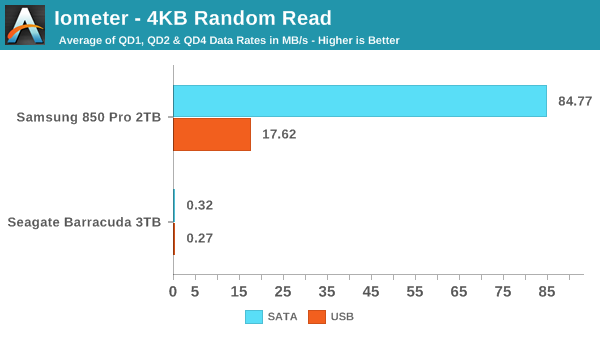
The impact of the dock on performance is much more severe for the random read test than for either of the sequential tests. The SSD's performance is only about a fifth of its native SATA speed despite the throughput in this test being nowhere near the limits of the dock. Even the painfully slow hard drive was measurably slowed by the dock, showing that it imposes a clear per-request latency overhead.
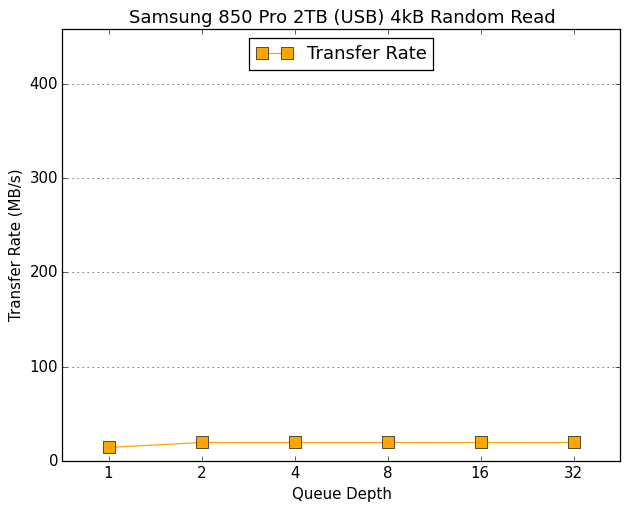 |
|||||||||
| Samsung 850 Pro 2TB (SATA) | Samsung 850 Pro 2TB (USB) | ||||||||
| Seagate Barracuda 3TB (SATA) | Seagate Barracuda 3TB (USB) | ||||||||
The queue depth scaling for the hard drive had to be graphed with a very different scale for performance, but we are able to observe the effect of Native Command Queuing. The overhead of the dock on the hard drive has the effect of reducing the queue depth to a fourth of its actual value. The SSD's performance in the dock across queue depths is mostly flat but again slightly slower at QD1.
Random Write Performance
The random write test is conducted with the same timing and queue depths as the random read test, but is limited to a 16GB span of the drive. For SSDs, this ensures that the drive has plenty of spare area to perform wear leveling and garbage collection without hurting performance. For hard drives, this greatly limits the maximum seek distance and thus improves the average seek time.
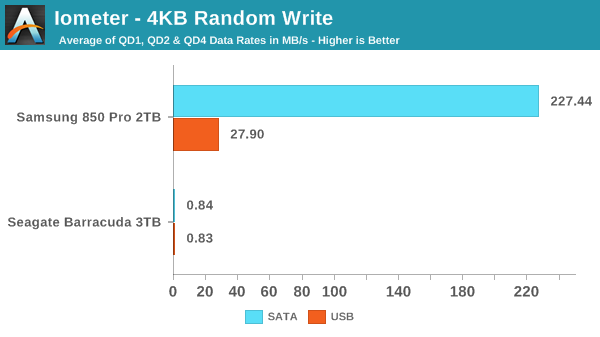
The key to the fast random write performance of SSDs even at low queue depths is that the drive will buffer writes, signaling completion before the data has actually been fully written to flash. Without this capability, the inherently slower write speed than read speed would be readily apparent. Even in the latency-challenged eraser dock, the SSD's quick turnaround time for write commands provides a significant benefit. For the hard drive, the overhead of the dock is very small and the restricted range of the test allows the random writes to be three times faster than the random reads across the entire disk.
 |
|||||||||
| Samsung 850 Pro 2TB (SATA) | Samsung 850 Pro 2TB (USB) | ||||||||
| Seagate Barracuda 3TB (SATA) | Seagate Barracuda 3TB (USB) | ||||||||
The queue depth scaling of the SSD doesn't present any surprises, but the hard drive's performance is interesting. Both in the dock and connected internally, the hard drive's performance peaks at QD4, suffers as the queue depth increases to 8 and 16, and recovers some at QD32. This might represent a limitiation of this drive's NCQ implementation. Note that the hard drive's drastically lower random I/O performance again required a different vertical scale from the SSD.
Mixed Random Read/Write Performance
The mixed random I/O benchmark starts with a pure read test and gradually increases the proprotion of writes, finishing with pure writes. The queue depth is 3 for the entire test and each subtest lasts for 3 minutes, for a total test duration of 18 minutes. This test is restricted to a 16GB span of the drive.
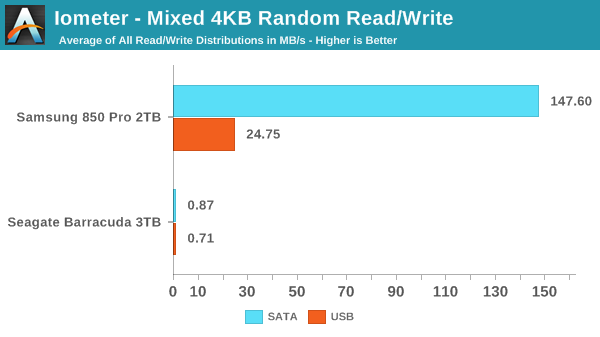
The overall scores on the mixed random test are unsurprisingly pretty similar to the separate random read and write scores. The limited span and increased queue depth help some, especially for the mechanical drive, while the SSD's averages fall between its random read and write scores. The dock continues to impose a severe performance penalty on the SSD and a slight one for the hard drive.
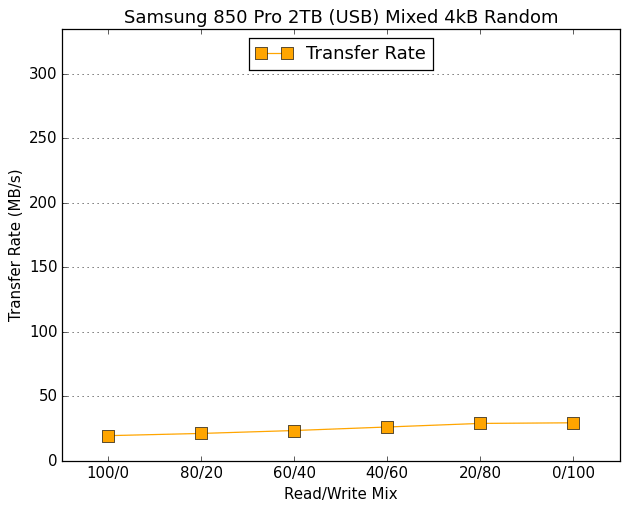 |
|||||||||
| Samsung 850 Pro 2TB (SATA) | Samsung 850 Pro 2TB (USB) | ||||||||
| Seagate Barracuda 3TB (SATA) | Seagate Barracuda 3TB (USB) | ||||||||
As with the other random tests, the hard drive had to be graphed on a different scale from the SSD. In the dock, the SSD demonstrates a slight increase in performance as the workload becomes more write-heavy and it is not able to show the large improvement when reaching the pure-write portion of the test. The hard drive's performance in the dock retains the same basic profile as when connected internally, but suffers in every subtest save for the pure-write portion.










38 Comments
View All Comments
Teknobug - Tuesday, February 16, 2016 - link
I had a pile of SCSI and ATA and some earlier SATA drives to a place to have them recycled, they told me it's $250 and better off just smashing them with a hammer- I shook my head at that advice and just left them sitting in the garage, even when formatting them they still have bits of data that people can retrieve and it's not worth paying $250 to recycle them.Camikazi - Tuesday, February 16, 2016 - link
I just take them apart when not busy and use the platters for decoration and other things. I'm sure someone somewhere can still get info from it if they really wanted too but I'm sure there are easier ways to get the info they are looking for.Beany2013 - Tuesday, February 16, 2016 - link
3.5" platters make excellently coasters for mugs.Horribly slippery and slidey, but very pretty.
Murloc - Wednesday, February 17, 2016 - link
do you really have secret data on them that is worth at least hundreds of dollars in work?duartix - Tuesday, February 16, 2016 - link
Do they sell a secure eraser to securely erase the secure eraser's log of secure erases?BrokenCrayons - Tuesday, February 16, 2016 - link
And if they do, what happens when you need to securely erase the secure eraser log eraser?Azethoth - Wednesday, February 17, 2016 - link
This is already built in. You choose the paper option and attach a large metal garbage can to print out into. When you need to erase you just burn it at night out in the parking lot. It provides heat for the hobos and in the morning you pour water in as the second erase cycle. Then you mulch that into your grass and flower beds and observe it 24/7 with security cameras just to be sure.a1exh - Tuesday, February 16, 2016 - link
I built one of these for OCZ UK (which at the time was Oxford Semiconductors) in 2005 using the OXUF931S. The BOM would have been far less than this. No DDR. No Xilinx chip. I2C eInk display. Just a USB->SATA bridge running custom firmware. While very useful here at work, when I suggested selling them I was told there was no market for them. I cannot imagine anything has changed.jardows2 - Tuesday, February 16, 2016 - link
The article got me thinking about a software solution. Looks like there are lots of utilities for "secure erase" but not all claim to be "certified." Anyone have experience with software solutions?Holliday75 - Tuesday, February 16, 2016 - link
Killdisk was used at my last job as a tech for a very large data hosting company. We used KD on most servers and servers considered to house high business impact data was physically destroyed using a shredder. During large decommission projects I would cry at the site of watching thousands of 300gb SAS drives being tossed into the chipper.